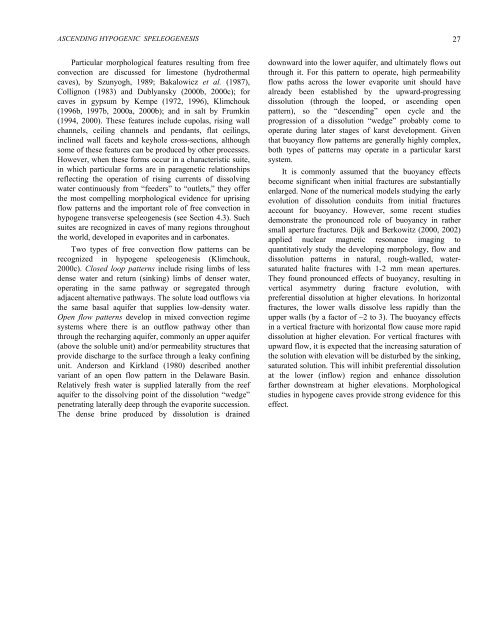Download PDF - Speleogenesis
Download PDF - Speleogenesis
Download PDF - Speleogenesis
Create successful ePaper yourself
Turn your PDF publications into a flip-book with our unique Google optimized e-Paper software.
ASCENDING HYPOGENIC SPELEOGENESIS<br />
Particular morphological features resulting from free<br />
convection are discussed for limestone (hydrothermal<br />
caves), by Szunyogh, 1989; Bakalowicz et al. (1987),<br />
Collignon (1983) and Dublyansky (2000b, 2000c); for<br />
caves in gypsum by Kempe (1972, 1996), Klimchouk<br />
(1996b, 1997b, 2000a, 2000b); and in salt by Frumkin<br />
(1994, 2000). These features include cupolas, rising wall<br />
channels, ceiling channels and pendants, flat ceilings,<br />
inclined wall facets and keyhole cross-sections, although<br />
some of these features can be produced by other processes.<br />
However, when these forms occur in a characteristic suite,<br />
in which particular forms are in paragenetic relationships<br />
reflecting the operation of rising currents of dissolving<br />
water continuously from “feeders” to “outlets,” they offer<br />
the most compelling morphological evidence for uprising<br />
flow patterns and the important role of free convection in<br />
hypogene transverse speleogenesis (see Section 4.3). Such<br />
suites are recognized in caves of many regions throughout<br />
the world, developed in evaporites and in carbonates.<br />
Two types of free convection flow patterns can be<br />
recognized in hypogene speleogenesis (Klimchouk,<br />
2000c). Closed loop patterns include rising limbs of less<br />
dense water and return (sinking) limbs of denser water,<br />
operating in the same pathway or segregated through<br />
adjacent alternative pathways. The solute load outflows via<br />
the same basal aquifer that supplies low-density water.<br />
Open flow patterns develop in mixed convection regime<br />
systems where there is an outflow pathway other than<br />
through the recharging aquifer, commonly an upper aquifer<br />
(above the soluble unit) and/or permeability structures that<br />
provide discharge to the surface through a leaky confining<br />
unit. Anderson and Kirkland (1980) described another<br />
variant of an open flow pattern in the Delaware Basin.<br />
Relatively fresh water is supplied laterally from the reef<br />
aquifer to the dissolving point of the dissolution “wedge”<br />
penetrating laterally deep through the evaporite succession.<br />
The dense brine produced by dissolution is drained<br />
downward into the lower aquifer, and ultimately flows out<br />
through it. For this pattern to operate, high permeability<br />
flow paths across the lower evaporite unit should have<br />
already been established by the upward-progressing<br />
dissolution (through the looped, or ascending open<br />
pattern), so the “descending” open cycle and the<br />
progression of a dissolution “wedge” probably come to<br />
operate during later stages of karst development. Given<br />
that buoyancy flow patterns are generally highly complex,<br />
both types of patterns may operate in a particular karst<br />
system.<br />
It is commonly assumed that the buoyancy effects<br />
become significant when initial fractures are substantially<br />
enlarged. None of the numerical models studying the early<br />
evolution of dissolution conduits from initial fractures<br />
account for buoyancy. However, some recent studies<br />
demonstrate the pronounced role of buoyancy in rather<br />
small aperture fractures. Dijk and Berkowitz (2000, 2002)<br />
applied nuclear magnetic resonance imaging to<br />
quantitatively study the developing morphology, flow and<br />
dissolution patterns in natural, rough-walled, watersaturated<br />
halite fractures with 1-2 mm mean apertures.<br />
They found pronounced effects of buoyancy, resulting in<br />
vertical asymmetry during fracture evolution, with<br />
preferential dissolution at higher elevations. In horizontal<br />
fractures, the lower walls dissolve less rapidly than the<br />
upper walls (by a factor of ~2 to 3). The buoyancy effects<br />
in a vertical fracture with horizontal flow cause more rapid<br />
dissolution at higher elevation. For vertical fractures with<br />
upward flow, it is expected that the increasing saturation of<br />
the solution with elevation will be disturbed by the sinking,<br />
saturated solution. This will inhibit preferential dissolution<br />
at the lower (inflow) region and enhance dissolution<br />
farther downstream at higher elevations. Morphological<br />
studies in hypogene caves provide strong evidence for this<br />
effect.<br />
27
















